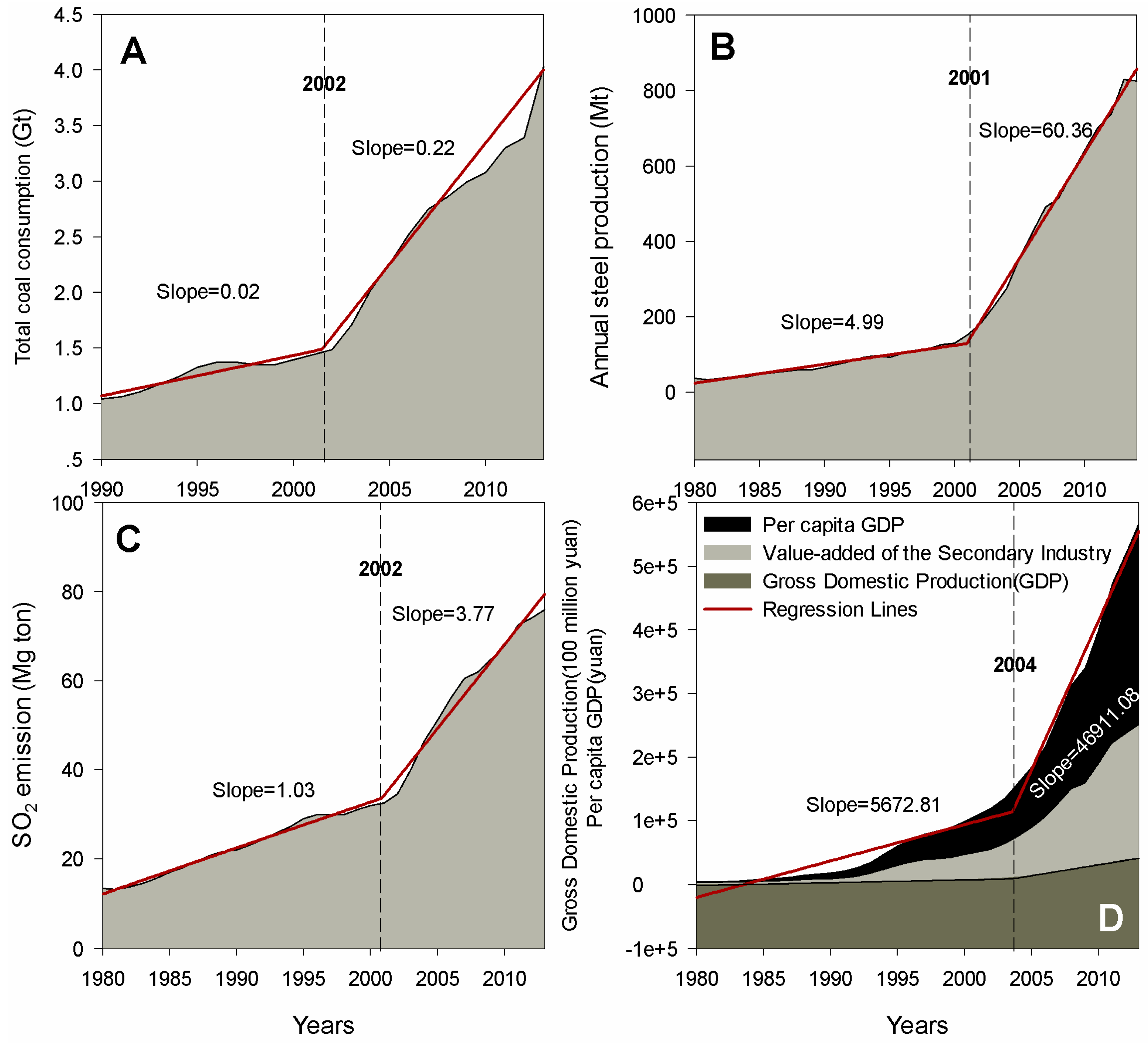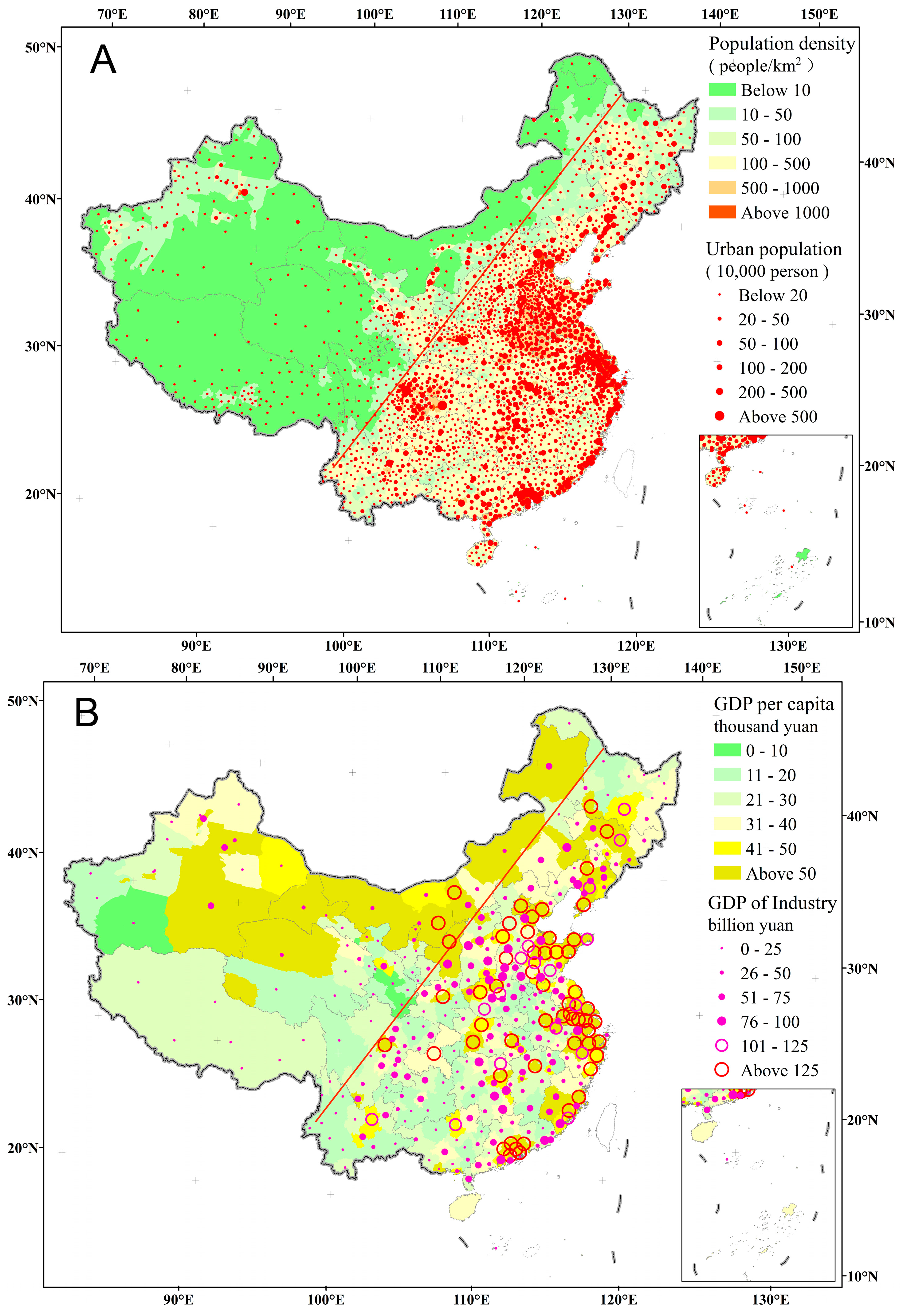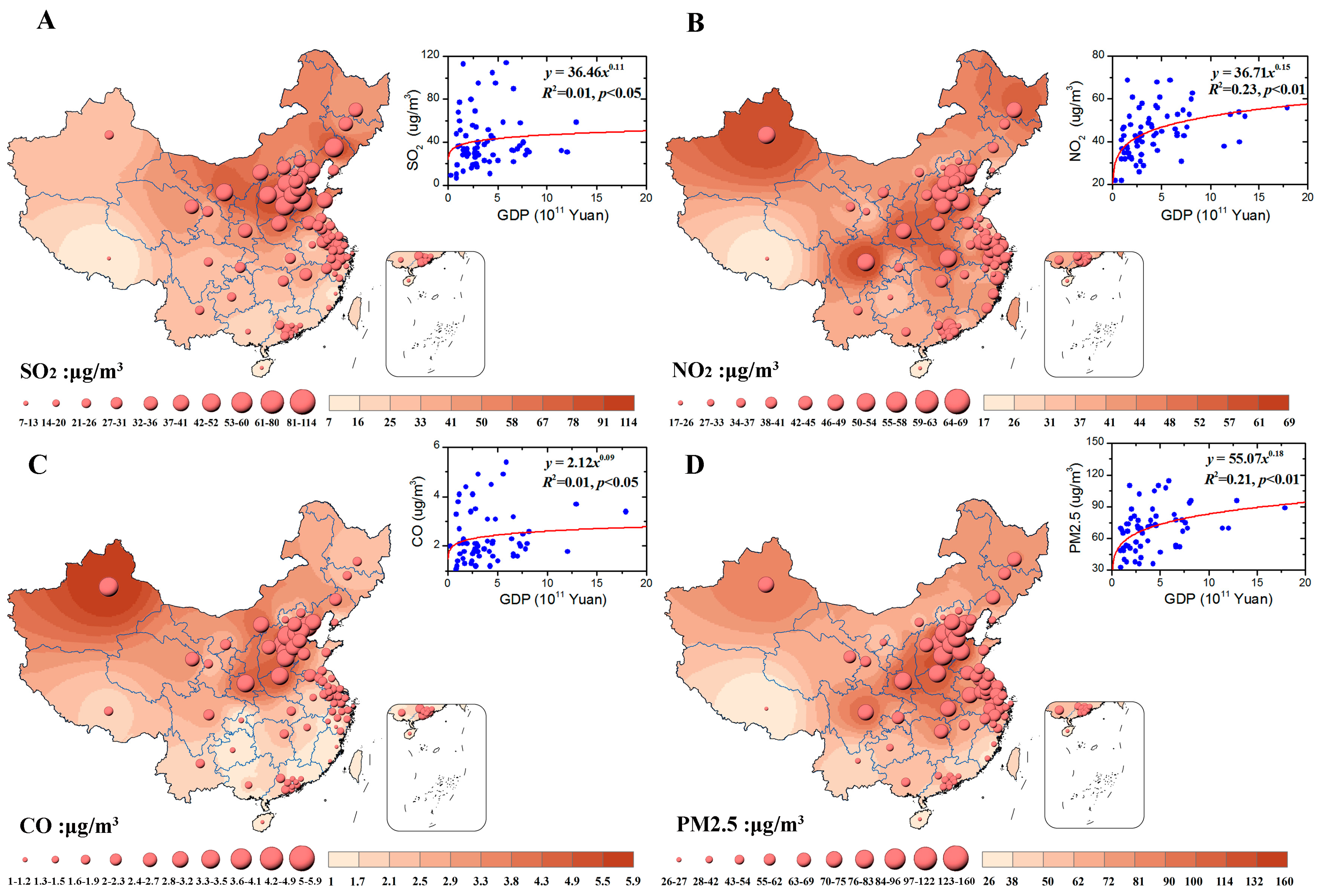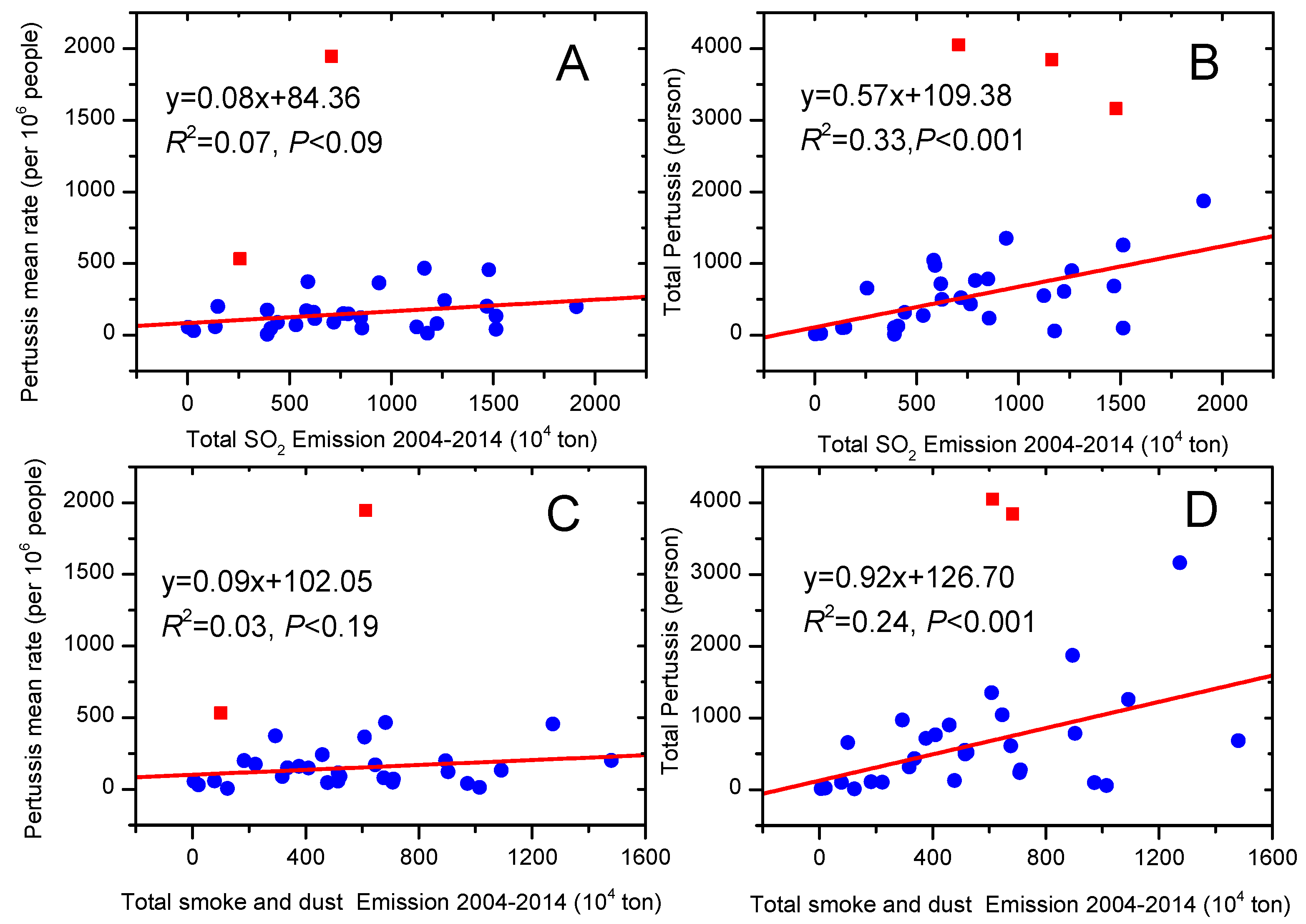The Haze Nightmare Following the Economic Boom in China: Dilemma and Tradeoffs
Abstract
:1. Introduction
2. Materials and Methods
2.1. Data Collection
2.2. Tools of Analysis
3. Results
3.1. Temporal Dynamics of Air Pollution, National Economic and Social Development
3.2. Spatial Dynamics of Air Pollution, National Economic and Social Development
3.3. Relationship between Air Pollution and Human Health
4. Discussion
4.1. The Relationship of Air Pollution with National Economic and Social Development
4.2. The Relationships between Human Health and Air Pollution
4.3. Limitations of the Current Study
4.4. The Long-Term National Strategic Development Plans
5. Conclusions
Acknowledgments
Author Contributions
Conflicts of Interest
References
- Lin, B.Q.; Liu, X. Dilemma between economic development and energy conservation: Energy rebound effect in China. Energy 2012, 45, 867–873. [Google Scholar] [CrossRef]
- Yuan, X.L.; Mu, R.M.; Zuo, J.; Wang, Q.S. Economic development, energy consumption, and air pollution: A critical assessment in China. Hum. Ecol. Risk Assess. 2015, 21, 781–798. [Google Scholar] [CrossRef]
- Jo, H.Y.; Kim, C.H. Identification of long-range transported haze phenomena and their meteorological features over northeast Asia. J. Appl. Meteorol. Clim. 2013, 52, 1318–1328. [Google Scholar] [CrossRef]
- Zhang, Z.L.; Wang, J.; Chen, L.H.; Chen, X.Y.; Sun, G.Y.; Zhong, N.S.; Kan, H.D.; Lu, W.J. Impact of haze and air pollution-related hazards on hospital admissions in Guangzhou, China. Environ. Sci. Pollut. Res. 2014, 21, 4236–4244. [Google Scholar] [CrossRef] [PubMed]
- Zhang, R.H.; Li, Q.; Zhang, R.N. Meteorological conditions for the persistent severe fog and haze event over eastern China in January 2013. Sci. China Earth Sci. 2014, 57, 26–35. [Google Scholar]
- Wang, K.; Liu, Y.N. Can Beijing fight with haze? Lessons can be learned from London and Los Angeles. Nat. Hazards 2014, 72, 1265–1274. [Google Scholar] [CrossRef]
- Zhen, N.H.; Fu, B.J.; Lu, Y.H.; Wang, S. Poverty reduction, environmental protection and ecosystem services: A prospective theory for sustainable development. Chin. Geogr. Sci. 2014, 24, 83–92. [Google Scholar] [CrossRef]
- Wang, W.; Zheng, G. Green Paper on Climate Change: A Report on Fighting Climate Change 2013; Social Sciences Academic Press: Beijing, China, 2013. [Google Scholar]
- National Bureau of Statistics in China. Available online: http://www.stats.gov.cn (accessed on 11 November 2015).
- China National Knowledge Infrastructure. Available online: http://www.cnki.net (accessed on 11 November 2015).
- National Health and Family Planning Commission of China. Available online: http://www.nhfpc.gov.cn (accessed on 11 November 2015).
- Zhang, H.M.; Qiu, F.D.; Wei, Q.; Tong, L.J.; Ye, X.Y.; Cheng, Y.Q. Economic development and energy efficiency in Jilin Province, China. J. Geogr. Sci. 2014, 24, 875–888. [Google Scholar] [CrossRef]
- Li, R.; Leung, G.C.K. Coal consumption and economic growth in China. Energy Policy 2012, 40, 438–443. [Google Scholar] [CrossRef]
- Zhang, X.H.; Wu, L.Q.; Zhang, R.; Deng, S.H.; Zhang, Y.Z.; Wu, J.; Li, Y.W.; Lin, L.L.; Li, L.; Wang, Y.J.; et al. Evaluating the relationships among economic growth, energy consumption, air emissions and air environmental protection investment in China. Renew. Sustain. Energ. Rev. 2013, 18, 259–270. [Google Scholar] [CrossRef]
- Li, J.Y.; Zhang, C.L.; Tian, J.L. Research on China’s economic growth and the consumption of energy in the low-carbon economy. Adv. Mater. Res. 2012, 361–363, 1897–1900. [Google Scholar] [CrossRef]
- Bai, Y.P.; Yang, J. Energy consumption—Economic growth relationship and carbon emissions in twelve provinces of west of China. Sustain. Environ. Transp. 2012, 178–181, 885–892. [Google Scholar] [CrossRef]
- Bing, J.; Rui, L. Economic analysis of energy efficiency in China’s economy. Actual Probl. Econ. 2011, 124, 367–372. [Google Scholar]
- Feng, T.W.; Sun, L.Y.; Zhang, Y. The relationship between energy consumption structure, economic structure and energy intensity in China. Energ. Policy 2009, 37, 5475–5483. [Google Scholar] [CrossRef]
- Yu, S.C. Water spray geoengineering to clean air pollution for mitigating haze in China’s cities. Environ. Chem. Lett. 2014, 12, 109–116. [Google Scholar] [CrossRef]
- Zhang, H.; Li, J.F.; Wang, H.L. Haze removal from single images based on a luminance reference model. Optik Int. J. Light Electron. Opt. 2014, 125, 4958–4963. [Google Scholar] [CrossRef]
- Wang, Z.; Feng, Y. Fast single haze image enhancement. Comput. Electr. Eng. 2014, 40, 785–795. [Google Scholar] [CrossRef]
- Smith, K.R.; Samet, J.M.; Romieu, I.; Bruce, N. Indoor air pollution in developing countries and acute lower respiratory infections in children. Thorax 2000, 55, 518–532. [Google Scholar] [CrossRef] [PubMed]
- Hertz-Picciotto, I.; Baker, R.J.; Yap, P.-S.; Dostá, M.; Joad, J.P.; Lipsett, M.; Greenfield, T.; Herr, C.E.; Beneš, I.; Shumway, R.H. Early childhood lower respiratory illness and air pollution. Environ. Health Perspect. 2007, 115, 1510–1518. [Google Scholar] [CrossRef] [PubMed]
- Zhao, W.C.; Cheng, J.P.; Li, D.L.; Duan, Y.S.; Wei, H.P.; Ji, R.X.; Wang, W.H. Urban ambient air quality investigation and health risk assessment during haze and non-haze periods in Shanghai, China. Atmos. Pollut. Res. 2013, 4, 275–281. [Google Scholar] [CrossRef]
- Lee, K.-Y.; Cao, J.-J.; Lee, C.-H.; Hsiao, T.-C.; Yeh, C.-T.; Huynh, T.-T.; Han, Y.-M.; Li, X.-D.; Chuang, K.-J.; Tian, L.; et al. Inhibition of the wnt/beta-catenin pathway by fine particulate matter in haze: Roles of metals and polycyclic aromatic hydrocarbons. Atmos. Environ. 2015, 109, 118–129. [Google Scholar] [CrossRef]
- Li, M.; Zhang, L. Haze in China: Current and future challenges. Environ. Pollut. 2014, 189, 85–86. [Google Scholar] [CrossRef] [PubMed]
- Xu, P.; Chen, Y.F.; Ye, X.J. Haze, air pollution, and health in China. Lancet 2013, 382, 2067–2067. [Google Scholar] [CrossRef]
- Emmanuel, S.C. Impact to lung health of haze from forest fires: The singapore experience. Respirology 2000, 5, 175–182. [Google Scholar] [CrossRef] [PubMed]
- Geng, G.; Zhang, Q.; Martin, R.V.; van Donkelaar, A.; Huo, H.; Che, H.; Lin, J.; He, K. Estimating long-term PM2.5 concentrations in China using satellite-based aerosol optical depth and a chemical transport model. Remote Sens. Environ. 2015, 166, 262–270. [Google Scholar] [CrossRef]
- Othman, J.; Sahani, M.; Mahmud, M.; Ahmad, M.K. Transboundary smoke haze pollution in Malaysia: Inpatient health impacts and economic valuation. Environ. Pollut. 2014, 189, 194–201. [Google Scholar] [CrossRef] [PubMed]
- Zhang, A.; Zhong, L.; Xu, Y.; Wang, H.; Dang, L. Tourists’ perception of haze pollution and the potential impacts on travel: Reshaping the features of tourism seasonality in Beijing, China. Sustainability 2015, 7, 2397–2414. [Google Scholar] [CrossRef]
- Pongpiachan, S.; Tipmanee, D.; Khumsup, C.; Kittikoon, I.; Hirunyatrakul, P. Assessing risks to adults and preschool children posed by PM2.5-bound polycyclic aromatic hydrocarbons (PAHS) during a biomass burning episode in northern Thailand. Sci. Total Environ. 2015, 508, 435–444. [Google Scholar] [CrossRef] [PubMed]
- Jin, S.; Guo, J.; Wheeler, S.; Kan, L.; Che, S. Evaluation of impacts of trees on PM2.5 dispersion in urban streets. Atmos. Environ. 2014, 99, 277–287. [Google Scholar] [CrossRef]
- Gao, M.; Guttikunda, S.K.; Carmichael, G.R.; Wang, Y.; Liu, Z.; Stanier, C.O.; Saide, P.E.; Yu, M. Health impacts and economic losses assessment of the 2013 severe haze event in Beijing area. Sci. Total Environ. 2015, 511, 553–561. [Google Scholar] [CrossRef] [PubMed]
- Lu, F.; Xu, D.; Cheng, Y.; Dong, S.; Guo, C.; Jiang, X.; Zheng, X. Systematic review and meta-analysis of the adverse health effects of ambient PM2.5 and PM10 pollution in the Chinese population. Environ. Res. 2015, 136, 196–204. [Google Scholar] [CrossRef] [PubMed]
- Liu, Z.; Guan, D.; Wei, W.; Davis, S.J.; Ciais, P.; Bai, J.; Peng, S.; Zhang, Q.; Hubacek, K.; Marland, G.; et al. Reduced carbon emission estimates from fossil fuel combustion and cement production in China. Nature 2015, 524, 335–338. [Google Scholar] [CrossRef] [PubMed]
- Pan, L.Y.; Guo, Z.; Liu, P.; Ma, L.W.; Li, Z. Comparison and analysis of macro energy scenarios in China and a decomposition-based approach to quantifying the impacts of economic and social development. Energies 2013, 6, 3444–3465. [Google Scholar] [CrossRef]
- Fang, Y.P. Economic welfare impacts from renewable energy consumption: The China experience. Renew. Sustain. Energ. Rev. 2011, 15, 5120–5128. [Google Scholar] [CrossRef]
- Chai, J.; Guo, J.-E.; Wang, S.-Y.; Lai, K.K. Why does energy intensity fluctuate in China? Energy Policy 2009, 37, 5717–5731. [Google Scholar] [CrossRef]
- Liao, H.; Fan, Y.; Wei, Y.-M. What induced China’s energy intensity to fluctuate: 1997–2006? Energy Policy 2007, 35, 4640–4649. [Google Scholar] [CrossRef]






| Items | Function 1 | Tipping Point | Function 2 | R2 | p |
|---|---|---|---|---|---|
| Annual coal consumption | Y = 0.02X − 37.47 | 2002 | Y = 0.22X − 434.83 | 0.99 | p < 0.001 |
| The demand for steel | Y = 4.99X − 9849.96 | 2001 | Y = 60.36X – 120,650.98 | 0.99 | p < 0.001 |
| Total SO2 emission | Y = 1.03X − 2022.61 | 2002 | Y = 3.77X + 5405.29 | 0.99 | p < 0.001 |
| Economic growth (PGDP) | Y = 5672.81X − 1.13 × 107 | 2004 | Y = 46,911.08X − 9.36 × 107 | 0.99 | p < 0.001 |
© 2016 by the authors; licensee MDPI, Basel, Switzerland. This article is an open access article distributed under the terms and conditions of the Creative Commons by Attribution (CC-BY) license (http://creativecommons.org/licenses/by/4.0/).
Share and Cite
Sun, J.; Wang, J.; Wei, Y.; Li, Y.; Liu, M. The Haze Nightmare Following the Economic Boom in China: Dilemma and Tradeoffs. Int. J. Environ. Res. Public Health 2016, 13, 402. https://doi.org/10.3390/ijerph13040402
Sun J, Wang J, Wei Y, Li Y, Liu M. The Haze Nightmare Following the Economic Boom in China: Dilemma and Tradeoffs. International Journal of Environmental Research and Public Health. 2016; 13(4):402. https://doi.org/10.3390/ijerph13040402
Chicago/Turabian StyleSun, Jian, Jinniu Wang, Yanqiang Wei, Yurui Li, and Miao Liu. 2016. "The Haze Nightmare Following the Economic Boom in China: Dilemma and Tradeoffs" International Journal of Environmental Research and Public Health 13, no. 4: 402. https://doi.org/10.3390/ijerph13040402
APA StyleSun, J., Wang, J., Wei, Y., Li, Y., & Liu, M. (2016). The Haze Nightmare Following the Economic Boom in China: Dilemma and Tradeoffs. International Journal of Environmental Research and Public Health, 13(4), 402. https://doi.org/10.3390/ijerph13040402








